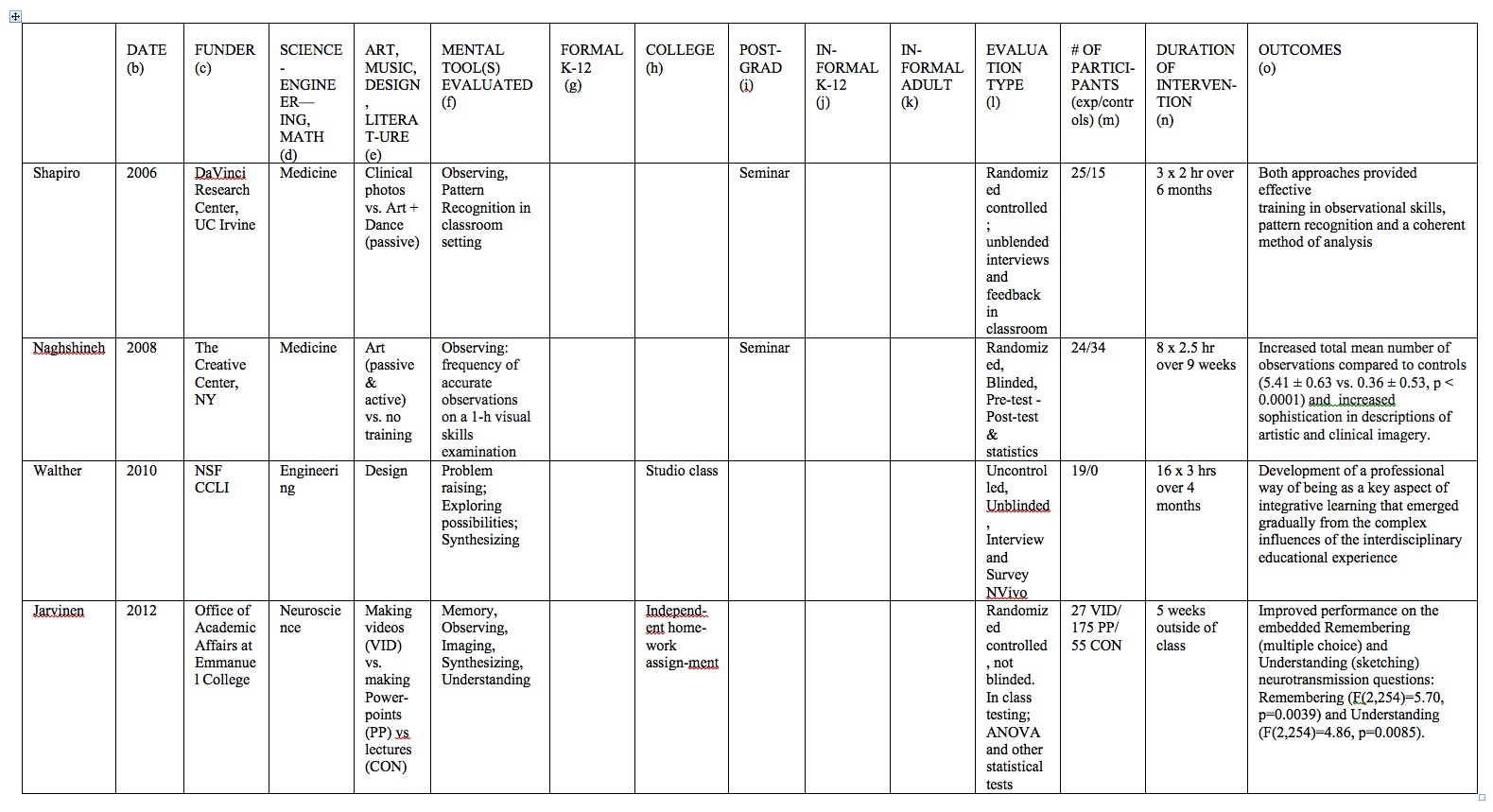
Call for SEAD Studies
To contribute, email Dr. Robert Root-Bernstein:
<rootbern@msu.edu>

(a) List by first FIRST AUTHOR and provide complete bibliographic reference after the Table. Also provide a PDF of the article, if possible.
(b) Provide date study was published (from bibliographic reference).
(c) Provide agency funding the study (e.g., National Science Foundation [NSF], National Institutes of Health [NIH], National Endowment for the Arts [NEA], name of private foundation, name of university, etc.)
(d) E.g., Mathematics, astronomy, physics, chemistry, biology, medicine, computer science, electronics, mechanical engineering, civil engineering etc. For K-12 it may simply be “arithmetic” or “science”. Can be more than one of these!
(e) E.g., Drawing, painting, sculpting, computer aided-design, architecture, music, singing, dancing, fabric arts, etc. May also include literature: playwriting, poetry, creative writing, theater, etc. Can be more than one of these! PLEASE NOTE IN PARENTHESES WHETHER THE INTERVENTION WAS ACTIVE (doing or participating in an artform) OR PASSIVE (observing or analyzing the art form).
(f) Problem raising; Problem solving; Exploring Possibilities; Critical thinking; Collaborating; Memory; Observing; Imagining; Abstracting; Patterning; Analogizing; Empathizing/Playacting; Body Thinking; Dimensional Thinking; Modeling; Playing/Exploring; Transforming; Synthesizing; etc.
(g) List grade levels or ages of participants.
(h) List type of classroom in which intervention occurred: lecture, recitation, laboratory, individual, etc.
(i) List type of classroom in which intervention occurred: lecture, recitation, seminar, laboratory, individual, etc.
(j) List type of informal setting: science museum or center, art museum, concert hall, community center, etc. Could include type of programming (tours, demonstrations, hands-on, combination, etc.) and targeted audience (general public, parents/children, teens, early childhood, etc.) ALSO LIST GRADE LEVELS OR AGES OF PARTICIPANTS.
(k) List type of informal setting: science museum or center, art museum, concert hall, community center, etc. Could include type of programming (tours, demonstrations, lectures, etc.) and targeted audience (general public, early 20s-30s, senior citizens, university crowd, etc.)
(l) E.g., Randomized; Controlled; Unblinded; Blinded; Double-Blinded; Anecdotal; Voluntary Survey; Required Survey; Compared with Control Group; Pre-Test/Post-Test; Statistical; etc. Can be more than one of these!
(m) List number of participants in study: always provide number of those receiving intervention / number of those in control group. If not controls, then provide the data like this: 27 / 0.
(n) How many classes or sessions of what length over how many months or years.
(o) SPECIFY OUTCOMES MEASURED: E.g., improved observational ability and pattern recognition; or increased generation of alternatives; or standardized test scores improved. Provide statistical value if available (e.g., p < 0.01 or r = .78); otherwise, “grade” the study: e.g., Very Significant; Possibly Significant; Poorly Implemented; No Effect; etc.
Bibliography
Jarvinen MK, Jarvinen LZ. 2012. Elevating student potential: Creating digital video to teach neurotransmission. The Journal of Undergraduate Neuroscience Education (JUNE), Fall 2012, 11(1):A6-A11
Naghshineh S, Hafler JP, Miller AR, Blanco MA, Lipsitz SR, Dubroff RP, Khoshbin S, Katz JT. 2008. Formal art observation training improves medical students’ visual diagnostic skills. J Gen Intern Med 23(7):991–7. DOI: 10.1007/s11606-008-0667-0
Shapiro J, Rucker L., Beck J. 2006. Training the clinical eye and mind: using the arts to develop medical students’ observational and pattern recognition skills. MEDICAL EDUCATION, 40: 263–268.
Walther J, Kellam N, Costantino T, Cramond B. 2010. Integrative learning in a synthesis and design studio: A phenomenological inquiry. 40th ASEE/IEEE Frontiers in Education Conference October 27 - 30, 2010, Washington, DC, S2F1-6.